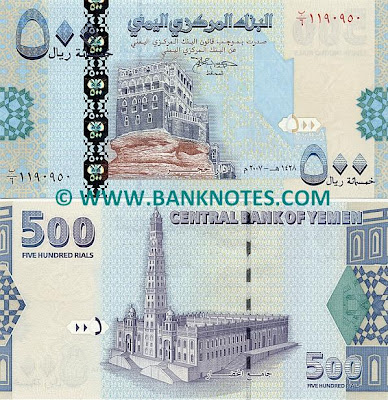During my last trip to Yemen in August 2012, I went with my cousin to a restaurant. I bought juice and told her that it's my treat. I opened my wallet and I took out two 200 Yemeni Rials (currency code YER) to pay. To my surprise my cousin bursted out laughing telling me that I may be the only person in Sana'a who still carries that currency. She may be right. I held on to my money since the last time I was in Yemen in 2009 and things have changed.
In this blog post, I go over the history of Yemen's currency since 1990.
Prior to 1990, the People's Democratic Republic of Yemen (South of Yemen) used the Dinar instead of the Rial. A single Dinar was the equivalent of one British pound which was made up of 20 Shillings. Below is the currency that the South used including an image of the 50 fils coin.

Well, there goes the 101 on Yemeni Currency. If you like this topic there is a book called "Currency of Yemen through the Ages: 2008 A.D - 1424 A.H" produced by Yemen's Central Bank. It has the biggest collections of Yemen's currency and represents the first effort by Yemen's government of sorting and cataloging its currency. Every once in a while, it is available on Amazon.
In this blog post, I go over the history of Yemen's currency since 1990.
Prior to 1990, the People's Democratic Republic of Yemen (South of Yemen) used the Dinar instead of the Rial. A single Dinar was the equivalent of one British pound which was made up of 20 Shillings. Below is the currency that the South used including an image of the 50 fils coin.
Image via ATSnotes.com
Coin from Wikimedia.org
Adeni Dinar (wikimedia.org)
Once unification occurred, one Dinar corresponded to 25 Rials. Even after unity, it was possible to see Dinars floating around in Yemen; however, they were officially terminated in June of 1996. Overall, a unified Yemen used the Rial (which is made up of 100 fils).
In the North of Yemen, around 1970, the government issued coins for 1, 5, 10, 25 & 50 fils. These coins were terminated by 1990 (especially since their value weakened).
Terminations continued well after unity. In 1993, the 1 and 5 rials coins were sacrificed even though they existed in paper form as well.
 |
| Image from CoinGallery.com |

 |
| 1 and 5 rials notes from here |
Other monetary units existed in both, coins and paper form. For example 10 Rials used to be a coin, however by 1995, the Central Bank decided to produce it as a bill. The 20 Rials suffered the opposite fate, it was typically in paper form till 2004 when it became a coin.
 |
| 10 Rial Coin from CoinGallery.com |
 |
| 10 Rial from Bank Notes |
 |
| 20 Rial from Coingallery.com |
 |
| 20 rials from Here |
Besides coins, there are different bills for the 50 and 100 Rials ever since inauguration of Yemen's unity. In 1996, the Central bank released the 200 YER bill, then in 1997 the 500 YER bill. Following that, in 1998, the 1000 YER bill made its debut. Finally, in 2009, a 250 YER bill came out which made the 200 YER bill impossible to find. Since I wasn't living in Yemen, it was easy to spot me as a visitor since I was using the 200 YER bill instead of the 250.
Well, there goes the 101 on Yemeni Currency. If you like this topic there is a book called "Currency of Yemen through the Ages: 2008 A.D - 1424 A.H" produced by Yemen's Central Bank. It has the biggest collections of Yemen's currency and represents the first effort by Yemen's government of sorting and cataloging its currency. Every once in a while, it is available on Amazon.











it means no thing or may be small thing
ReplyDelete